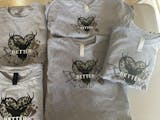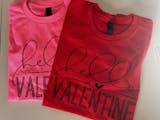Transforming your apparel design can be easier than you think. Are you tired of limited options when it comes to unique styles? Custom DTF transfers offer a fantastic solution, allowing you to personalize any fabric with eye-catching designs. This post will guide you through choosing the right fabric, mastering the application process, and exploring effective marketing strategies. By understanding these key areas, you’ll gain insights on maximizing the impact of your designs and ensuring your custom heat transfers ship for free. Say goodbye to dull clothing options and embrace the creative potential of custom transfers today.
Change the Game With Custom DTF Transfers for Apparel Design
Understanding the fundamentals of DTF transfer technology is essential for those looking to innovate in apparel design. Custom DTF transfers offer significant benefits, such as quick turnaround time and compatibility with various materials, including wood. This section will also compare DTF printing with other printing methods, highlighting how heat application plays a crucial role in the process and results.
Understand the Fundamentals of DTF Transfer Technology
DTF (Direct to Film) transfer technology has gained traction among apparel designers seeking innovative solutions for branding their products. This technique utilizes specialized film and ink to produce high-quality images or logos, which can then be transferred onto various fabrics, including cotton. The process involves printing on a special DTF paper, which retains vibrancy and durability, making it ideal for a range of applications from custom t-shirts to promotional items.
One of the standout advantages of DTF transfers is the versatility in material compatibility, allowing designers to create stunning graphics that adhere seamlessly to different substrates. For instance, it enables the addition of unique logos to garments while maintaining the soft texture of cotton and other fabrics. This technology gives merchants the capability to fill their shopping cart with custom-designed clothing that meets consumer demands for personalization and quality, making it a valuable asset in the competitive landscape of apparel design.
Investigate the Benefits of Custom DTF Transfers for Clothing
Custom DTF transfers are an excellent choice for apparel designers looking to enhance their products with vibrant colors and unique designs. DTF heat transfer technology allows for the application of detailed graphics onto various materials, including spandex and cotton, without compromising the fabric's feel. This flexibility not only caters to diverse consumer preferences but also supports businesses in standing out in a crowded marketplace.
Moreover, the efficient application of DTF transfers can lead to valuable cost savings for businesses. High-quality prints adhere well, resembling the look of direct prints while ensuring durability, which translates to reduced returns and increased customer satisfaction. Solid customer service coupled with the reliability of DTF transfers means that brand owners can confidently meet consumer demand, solidifying their position in the apparel industry while offering personalized options that resonate with their audience.
Compare DTF Transfers to Other Printing Methods
DTF transfers stand out when compared to traditional printing methods, such as screen printing or heat transfer vinyl, primarily due to their efficiency and versatility. Unlike screen printing, which may require multiple screens for different colors and can be costly for small runs, DTF technology allows for direct printing of complex designs in vibrant colors at a lower sale price. This flexibility supports businesses by enabling them to adapt their stock more readily and meet diverse consumer demands without significant upfront investment.
When evaluating printing methods, the durability of DTF transfers is also a key advantage. They provide high-quality finished products that rival direct-to-garment prints, making them suitable for brands that prioritize longevity and branding consistency. As a result, businesses can enhance their offerings with custom designs while minimizing returns and boosting customer satisfaction, ultimately creating a strong competitive edge in the apparel market.
Choose the Right Fabric for Optimal DTF Transfer Results
Identifying suitable materials is crucial for successful custom DTF transfer applications. Recommended fabrics, such as cotton and polyester blends, enhance the durability and texture of the final print, ensuring customer satisfaction. The following sections will assess these fabrics in detail, explore the benefits of using a gang sheet builder for efficient quantity management, and highlight the role of PNGand SVG designs in creating lasting apparel.
Identify Which Materials Work Best for DTF Printing
Choosing the right materials is essential for achieving vibrant, long-lasting DTF prints on apparel. Fabrics such as cotton and polyester blends work exceptionally well due to their excellent adhesion properties and ability to showcase detailed images. Additionally, nylon, while requiring specific attention during the application process, can produce stunning results when paired with the correct adhesives, making it a viable option for fashion-forward items like athletic wear or stylish sweatshirts.
Understanding the characteristics of different fabrics allows designers to tailor their projects effectively. For instance, using cotton for t-shirts or sleeves ensures a soft feel while maintaining print integrity. Similarly, blending fabrics can provide durability without sacrificing aesthetics, enabling the creation of unique designs that resonate with consumers seeking distinct apparel options. This strategic material selection plays a crucial role in transforming the overall quality of custom DTF transfers.
Assess Durability and Texture of Recommended Fabrics
When assessing the durability and texture of fabrics for DTF transfers, cotton stands out as an excellent option due to its natural fibers, which promote comfortable wear and effective heat press application. The softness of cotton allows for a pleasant feel against the skin while also adhering well under pressure during the transfer process. Incorporating fabrics like polyester blends enhances both durability and the vibrancy of colors, ensuring that prints withstand repeated washes and maintain their quality over time.
The use of heat transfer methods such as sublimation on the right materials can yield impressive results, providing long-lasting prints that remain intact. Understanding how different fabrics respond to heat and pressure is key; brands that strategically select their textiles can significantly reduce costs associated with returns and reprints, ultimately improving payment processing and shipping efficiency. Choosing the right fabric ultimately contributes to a successful apparel transformation, allowing businesses to meet customer expectations while showcasing unique designs.
Personalize Your Apparel With Unique DTF Transfer Designs
Creative DTF artwork ideas can inspire customers to elevate their clothing with unique designs. Users can easily upload their custom graphics for transfer printing, capturing attention and reflecting personal style. This section will offer practical insights into creating standout DTF transfer designs, ensuring that each piece resonates with the target audience.
Get Inspired by Creative DTF Artwork Ideas for Clothing
Designers can enhance apparel uniqueness by incorporating creative DTF artwork ideas that resonate with their target market. For instance, using opal colors in custom heat transfer designs adds an eye-catching element to shirts, making them stand out. These vibrant hues not only elevate the aesthetic but also reflect individual styles, catching the attention of potential buyers.
Another approach involves utilizing adhesive technology to apply intricate patterns or motifs that showcase brand identity. For example, artists can create personalized designs that feature a “password" theme, appealing to specific interests or movements. Such tailored graphics on garments enrich the shopping experience, ensuring consumers find clothing that aligns with their tastes and preferences.
Learn to Create Your Own DTF Transfer Designs Easily
Creating custom DTF transfer designs is a straightforward process that allows anyone to express their personal style effectively. Designers start by selecting the appropriate software to create vivid graphics that leverage the benefits of DTF transfer printing. The right ink can produce high-quality, vibrant images that stand out when transferred onto various items, including jerseys, ensuring that each piece is unique and appealing.
Incorporating templates or using "our gang" approach, where design elements are shared and collaboratively enhanced, can streamline the design process. This method not only fosters creativity but also enables users to quickly create eye-catching transfers. With user-friendly tools available, anyone can easily master the art of DTF design, providing a powerful way to personalize apparel and connect with customers on a deeper level.
Master the DTF Transfer Application Process Effectively
To successfully apply custom DTF transfers and transform clothing, one must gather essential tools, including DTF gang sheets, heat presses, and fabric softener. Following step-by-step instructions will enable effective application, ensuring vibrant prints. This section will outline the necessary supplies and provide methods for applying DTF transfers, ensuring a professional finish for apparel, ideal for any occasion, including Christmas.
Gather Essential Tools for Successful DTF Transfer Application
To achieve successful applications of custom DTF transfers, gathering essential tools is critical. A high-quality heat press is indispensable, as it provides the consistent temperature and pressure needed to transfer designs onto various materials, including leather and glitter finishes. Alongside the heat press, having appropriate DTF gang sheets minimizes waste and allows designers to efficiently utilize transfer paper, maximizing the number of designs that can be printed in one go.
In addition to the heat press and gang sheets, using the right adhesive and HTV (heat transfer vinyl) is vital for enhancing the durability of the prints. High-quality adhesives ensure that designs adhere well to different substrates while maintaining their integrity after multiple washes. Understanding how these tools work together enables designers to create custom apparel effectively, addressing the need for high-quality, long-lasting designs that resonate with consumers.
Follow Step-by-Step Instructions for Applying DTF Transfers
Applying DTF transfers effectively requires careful preparation and attention to detail. The initial step involves setting up a reliable heat transfer device, ensuring that the temperature is adjusted accurately based on the fabric type used. It’s vital to use the correct file format for the design, as this will directly influence the clarity and quality of the printed image when transferred onto the garment.
After preparing the heat press, the next stage is aligning the DTF transfer properly on the chosen apparel. This step is essential to avoid any misplacement during the heat application process, which can affect the final look. Following the appropriate time and pressure settings will ensure that the ink adheres correctly, resulting in vibrant designs that can withstand regular wear and washing, providing an alternative to traditional embroidery techniques.
Maximize Longevity and Quality of Your DTF Transfers
Implementing proper care guidelines for DTF printed apparel is essential for maintaining the vibrancy and durability of DTF transfers, especially when using materials like polyester. This section will provide insights on how to troubleshoot common issues encountered during the application process, ensuring that DTF prints remain high-quality over time. Additionally, utilizing the right tools and ensuring proper file formats, such as PDF, can enhance overall results.
Implement Proper Care Guidelines for DTF Printed Apparel
To maintain the vivid appearance of DTF printed apparel, it's crucial to follow specific care guidelines. Washing garments inside out can help protect the integrity of the prints, ensuring that the colors remain vibrant for longer. In addition, using cold water and mild detergents can minimize the risk of fading, allowing the original designs to shine as brightly as they did on the first day.
Avoiding harsh chemicals and refrain from dry cleaning is essential for preserving the quality of DTF transfers. For those using tools like Cricut to create designs, it is often helpful to avoid placing garments in direct sunlight for extended periods. Following these care tips not only enhances the longevity of the prints but also reinforces the commitment to quality in color printing, ultimately leading to satisfied customers who appreciate the attention to detail.
Troubleshoot Common Issues When Using DTF Transfers
Common issues with DTF transfers can arise from improper settings or inadequate preparation. For instance, if a hoodie begins to peel after washing, it may indicate a problem with the heat pressure or temperature used during the application. Adjusting software settings when creating a custom gang sheet can ensure accurate alignment, resulting in a smoother transfer process that enhances the overall quality of the inventory.
Troubleshooting also involves inspecting the DTF gang sheet for any inconsistencies before printing. If the design doesn't adhere correctly, checking the compatibility of the fabric with the transfer material is essential. This proactive approach helps prevent future complications and enables designers to deliver high-quality, long-lasting prints that meet customer expectations.
Explore Marketing Strategies for Custom DTF Apparel
Utilizing social media effectively is crucial for promoting DTF printed clothing lines, allowing brands to engage with potential customers in impactful ways. Developing targeted campaigns focused on apparel enthusiasts can further enhance visibility and attract attention. This section will provide insights on leveraging digital platforms to showcase textile designs and optimize productivity, alongside strategies for using formats like PNG for marketing graphics that rival traditional methods such as screen printing and glass printing.
Utilize Social Media to Promote DTF Printed Clothing Lines
Social media serves as a powerful platform for promoting custom DTF apparel, allowing brands to showcase their unique designs, including t-shirts, decals, and buttons. By sharing engaging visuals of products made with heat transfers, businesses can capture the attention of potential customers while highlighting the creativity behind each garment. Regularly posting images of customized items created using gang sheets can create excitement and encourage users to interact, fostering a sense of community around the brand.
Integrating user-generated content also strengthens a brand’s social media presence. Encouraging customers to share their experiences with custom DTF designs—like stickers or apparel—can generate authentic testimonials that resonate with followers. This approach not only builds trust but also provides valuable insight into how these products enhance personal style, influencing others to explore the versatility and customizability that DTF transfers offer.
Develop Targeted Campaigns to Attract Apparel Enthusiasts
To capture the attention of apparel enthusiasts, brands should create targeted campaigns that highlight the unique graphics of their custom DTF transfers. By showcasing vibrant designs that resonate with specific consumer demographics, businesses can drive traffic to their websites. Incorporating compelling visuals and pricing information in online promotions encourages potential customers to add products to their cart, enhancing potential sales.
Moreover, addressing common concerns, such as the durability of designs against bleach and regular wear, can further strengthen a brand's appeal. Providing clear examples of customer satisfaction and the quality of DTF printed apparel builds trust and engagement. These strategies not only attract attention but also empower consumers to make informed decisions about their purchases.
Conclusion
Custom DTF transfers revolutionize apparel design by offering vibrant, durable graphics that appeal to consumer preferences. This innovative technology allows designers to utilize various fabrics while maintaining the quality and feel of garments. By choosing suitable materials and effectively applying these transfers, businesses can enhance their product offerings, driving customer satisfaction and loyalty. Embracing DTF technology empowers brands to stand out in a competitive marketplace, delivering unique and personalized apparel designs that resonate with their audience.








